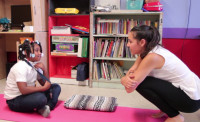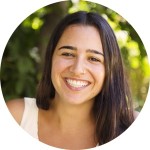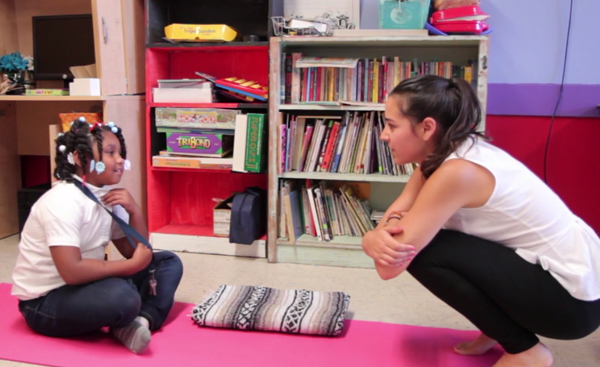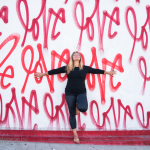My book The No-More-Excuses Guide to Yoga got me thinking about all the ways in which people are excluded from yoga – reasons like social class, race, money, incarceration or general access.
Much as we like to think yoga is accessible for all and inclusive, the reality is that there are many barriers which prevent large numbers of our populations from benefiting from it’s practice. I wanted to highlight the work that is being done to bring yoga to all the people and hopefully inspire other yoga teachers to think about ways they can reach out with yoga in their communities.
The first yoga teacher I’m featuring is Maya Weir. She is currently running a Kickstarter Campaign to fund her Community Yoga Project into it’s second year – but I’ll let her tell you all about it.
By guest author Maya Weir, Community Yoga Project
In the first month of my community yoga project classes, I received vital feedback from a student:
I really like the yoga because you make the actual yoga very accessible. I saw people going upside down in one class before and I knew I couldn’t do that so I didn’t go. I like how you make it gentle.
This got me thinking about what access means in a field like yoga.
Initially in planning Community Yoga Project, I focused on access in the sense that many marginalized communities for lack of funds, or cultural stigma, or proximity to yoga studio will not have access to a yoga class.
What I did not think about is the actual accessibility of the practice itself. What I learned is that making yoga accessible means making the actual practice accessible as well as the location or cost of the class. This has become my life’s work, making yoga accessible in myriad of ways: the actual practice, cost, location, cultural sensitivity, trauma awareness, etc.
I will explain the journey that got me to this undertaking and perhaps through my story be able to provide guidance for others with a similar path.
When I was 18, there was an illness in my family; this is what brought me to yoga. As part of the healing process, I began going to yoga classes as a way of supporting my family. I immediately fell in love with the practice.
Growing up, I had never liked the competitive nature of sports. In fifth grade, I spirally fractured my tibia thus causing me years of knee pain. Due to this injury and my inadequacy with sports, I had shame in my body and my perceived lack of ability.
Yoga transformed this shame into love as I was given space to accept my body as is and explore it from the starting point of wholeness.
Being, breathing and stretching to my ability was enough. I became more confident in my abilities as well as compassionate towards the pains in my body.
When I entered college, I continued to practice yoga on a regular basis, relying on that time to ground myself amongst the chaos of my college life. A few years later, I wanted to deepen my knowledge of yoga so I decided to partake in a 200 hour yoga teacher training.
This time period was full of change and transformation for me as I learned better ways to care for myself and ways to share this care with others.
I remember one of the first requirements of the teacher training was to meditate on a daily basis. I went up to the teacher and told him,
Meditation isn’t for me. I think it’s boring.
He responded,
Maybe try looking behind the boredom.
What I discovered behind my boredom were many fears, especially fear of being with myself and with my thoughts. Realizing this created a profound shift for me; I now find comfort in my regular meditation practice where I cultivate a loving relationship towards myself and my thoughts.
One thing that was difficult for me in my first teacher training was the lack of conversation around privilege and access.
I felt that I could not bring my full self into the training and that compelled me to think about other ways to engage with yoga.
After completing the teacher training, I decided to create a yoga project committed towards my values of social justice and healing. More specifically, I wanted to create a project where communities marginalized by race, class and mental health status would have access to yoga.
I spent months nannying in the afternoon and sitting in cafes in the morning writing out a grant for Community Yoga Project. I was accepted for the first round of interviews; I had never been so nervous for an interview in my life.
A week later, during the month of May 2013, I was notified that I had received the University of California, Berkeley’s Judith Lee Stronach Prize for Community Yoga Project, a year-long social justice yoga project. I was ecstatic! My dream and vision were becoming a reality.
For the next year, I partnered with several social justice organizations and taught classes at their site on a weekly basis.
Community Yoga Project’s mission was to provide therapeutic and trauma informed yoga classes where access to yoga is typically absent. More broadly, the aim was to improve the emotional and physical health and wellness of marginalized communities in the East Bay Area of California.
Through the process of the last year, I have learned so much about service, society, myself, energy, holding space for others, yoga, illness, mental health, homelessness, history, trauma, intergenerational trauma and more.
However, the most profound thing I have learned is how to truly love myself and have compassion for myself. I am grateful to each and every one of my students for allowing me to guide them in yoga and for the way they have guided me in this journey of love and compassion. I am forever grateful.
What I have come to realize is that the existence of yoga studios is not enough.
If we really want to be of service as yoga teachers we need to think about how to actively make yoga accessible. For me, that has meant creating Community Yoga Project; I have found value in bringing yoga into diverse spaces: homeless shelters, housing rights organization, recreation centers.
Providing free yoga in diverse spaces creates access for many that would otherwise not be unable to attend a class. Making the yoga fit the space and needs of participants rather than making people fit into an idea of “yoga” is the underlying message of this approach. There is much to be done in terms of breaking down barriers to health and wellness practices and providing yoga in new and creative spaces is one way to ensure broader access to yoga.
I had a student tell me after class once,
Thank you for teaching me how to take care of my body.
I was very touched by this statement. It’s statements like this that motivate me to do the work that I do. I feel blessed to have been trained in yoga and because of this privilege I feel compelled to share this gift with others.
My intention for Community Yoga Project is to honor the struggle and the strength within each of us and to create space for whole people to thrive.
My ultimate vision is to spread healing yoga and wellness classes to all who wish to participate so that it is truly accessible and to create a world where health, healing and connection are at the center of our day to day lives.
So let’s all take a breath, close ours eyes if it’s comfortable, and see if we can honor our whole being as it is in this moment.
Maya is running a Kickstarter campaign to raise the funds to continue her Community Yoga Project into it’s second year. You can donate here before it’s closing date of Monday October 6, 2014. She needs $27,000 to fund the project. Every $5 counts!
 About Maya:
About Maya:
Maya is a certified yoga instructor; for the past year, she has directed, Community Yoga Project, which seeks to increase access to the practice of yoga by holding classes at various social justice organizations in the East Bay Area. In addition to her community classes, she also sees private clients who seek therapeutic yoga for chronic conditions. For more information about the CYP and to see Maya’s Kickstarter Campaign, please click here.
To follow Maya on facebook or visit her website, Yoga with Maya Weir.

 About Maya:
About Maya:

Leave a Reply